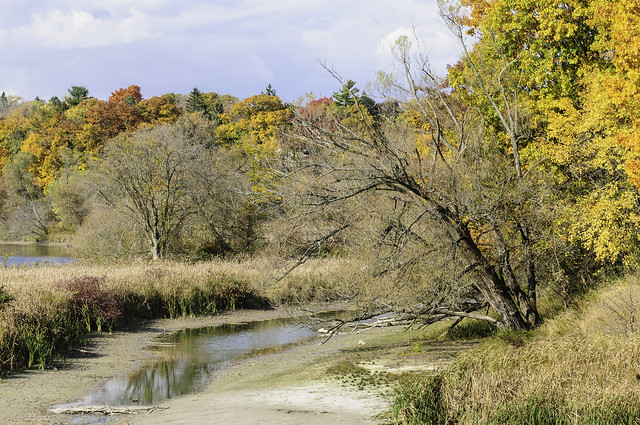Source: earthisland.org
Published: August 3, 2016
Canada’s Rouge National Urban Park embraces a diversity of landscapes
Kinjal Dagli-Shah
A valley with 10,000 years of human history is evolving into Canada’s first national urban park, with urban being the operative word. Rouge National Urban Park (RNUP), which was established in 2015 and spans 79 square kilometers — 22 times the size of New York’s Central Park — is spreading its roots in Canada’s largest and most culturally diverse metropolitan area, the Greater Toronto Area, making it one of the largest urban parks in the world.
The park includes a wide diversity of landscapes, including land in Toronto, Markham, and Pickering, and some 75 working farms. Twenty percent of Canadians live within an hour’s drive from the park.
Environmentalists had been pushing for the establishment of the park for decades in order to protect the Rouge River Valley ecosystem, which lies within Canada’s endangered Carolinian Life Zone and is home to fragile forest and wetland areas, and more than 1,700 species of plants and animals. The river and valley ecosystem, which is encircled by more than 100 square kilometers of publicly owned Greenbelt lands, lies right next to one of Canada’s most-urbanized areas.

photo by Michael Swan RNUP is Canada’s first urban national park.
Human presence in this ecosystem dates back tens of thousands of years, beginning with aboriginal hunters and farmers, explorers, traders, surveyors, and finally European settlers. More than 1,360 archaeological and heritage sites located within the watershed as well as historical accounts reveal the watershed area is rich in heritage value.
The rich environmental and cultural significance of Rouge Valley made it a prime candidate for protection. But due to its unique make-up, the process of establishing the park has been tricky and has, in some instances, pit environmentalists against farmers.
To accommodate a variety of land uses, Parks Canada, the country’s national parks agency, has recognized three distinct areas within the park – park areas, agricultural areas, and infrastructure and built assets – and uses a different management approach for each.
Many in the environmental community have raised concerns about the level of ecological protections in the Rouge, pointing out that environmental protections in the urban park are weaker than in other Canadian national parks, and that as a result, RNUP fails to meet the international definition of a protected area.
In June this year, however, the Canadian government proposed amendments to the Rouge National Urban Park Act to address these issues. If passed, conservation will be prioritized within the park, and the park boundaries expanded by another 17 square kilometers. Working farms, however, will be permitted to continue operations.
Environmental groups have applauded this decision. “This is huge,” Janet Sumner, executive director for CPAWS Wildlands League, said in a statement. “Nature will come first.”
Farmers, who have been concerned about restoration efforts associated with the park, also seem content with the amendments, which provides for longer, 30-year land leases.
Eighty-two-year-old farmer George Reesor was born and raised in what is now the Park area. “My ancestors arrived from Pennsylvania in 1804 to buy and settle 25 lots,” or roughly 1200 acres, Reesor said. “I farmed the land for 30 years.” His son Dale continues to farm there and raise his family of seven.
The last decade in the Rouge has been difficult for Dale and other farmers like him. The land they owned was expropriated in the 1970s for an airport that is yet to be built. Local families who were forced to sell their land for the project have been leasing their property back from the government ever since. But with five-year leases that could be terminated with a year’s notice, it became hard for farmers to make longterm agricultural plans. Proposals to reforest parts of the park also seemed to threaten agriculture in the region.
“[Previously,] there was no representation from agriculture on the Rouge Park Alliance, which was the governing body. And therefore, the entire focus was on reforestation and habitat restoration,” said Dale Reesor, who lost his best land, roughly 150 acres, to reforestation efforts a few years ago. “It was Class 1 agricultural land,” the most fertile type, he added. “The biggest threat was having people wanting to plant trees on my fields. I lost 20 percent of the land I farmed on but there was nothing I could do.”
His father George Reesor doesn’t mince words. He loves the park but also his family farmland. “The planting of trees is commendable if they are planted on marginal land. Dale has been impacted by the planting of trees on some of his most productive farmland,” he said.
All that changed when the RNUP was formally established in May last year, with agriculture as one of its four major pillars of conservation. “Parks Canada has been collaborating with park farmers to reconfigure and replant hedgerows with native trees, improve agricultural access to roads and crossings, control problematic invasive species like Manitoba Maple and Buckthorn, and promote the presence of beneficial wildlife – pollinators, birds, snakes,” said Veinotte, part of the compromise between environmental groups and farmers in the region. “Parks Canada is also working with farmers to examine the potential for channel redesign and regrades to improve both stream health and agricultural drainage throughout the park.”
By roping in farmers to be a part of the consultation and planning, the RNUP has adopted a democratic approach. Mike Whittamore, a sixth generation farmer who grows strawberries, raspberries and 15 different vegetables, runs a “pick your own” business smack in the middle of the Rouge. Like the Reesors, he faced a difficult few decades when his land was expropriated and he had to rent it back from the government. With the new plan for the RNUP, Mike is excited about the future. He believes the park is an initiative ahead of its time.
“I was thrilled to know that the government is working to give us a 30-year lease,” he said. “In the 35 years that I have farmed, this is the best outcome I could have hoped for. We can now do the long-range planning that sustainable farming is based upon. Agriculture is now going to be part of the solution to achieve ecological integrity of the land.”
Whittamore believes that a park with farms lining the urban landscape presents a robust plan for educating people about farmland ecosystems. “In an urban population, most people don’t know where their food comes from and how it is produced. The new national urban park will address some of these concerns with its accessibility,” he explained.
It is estimated that more than 75 percent of the current Rouge Park landscape has been altered or disturbed in some way, whether by farming or industrialization. With that in mind, Parks Canada is also working hard to restore native landscapes. “Restoring the Rouge’s native ecosystems is our prime concern,” said Veinotte. “Parks Canada has already begun working on restoration projects with municipalities, environmental groups and local farmers by reintroducing endangered turtles, making it easier for wildlife to cross park roads, and enhancing the health of agricultural wetlands.”
Restoration efforts are well under way. Four new wetlands, seven re-naturalized areas, 21 baby Blanding’s turtles and 3,000 native trees and shrubs all took home in the Rouge within the last year with the help of volunteers, school students, teachers, First Nations representatives, as well as community organizations and conservation groups.
Larry Noonan, who grew up right beside the Rouge Valley, is a champion of the RNUP and calls himself its “unofficial historian.” The former environmental studies teacher has led numerous hikes along trails in the Rouge and studied archaeological sites, gathering vast knowledge of the park. “There has been a very high concentration of native participation in the formation of the national park and I hope that Parks Canada will continue to confer with them as time progresses,” said Noonan. “Right from history and archaeology to the early settlers’ stories, there is a lot to be unearthed at Rouge National Urban Park.”
With a $15 million investment announced in July 2015 by the Canadian government, the RNUP is slated to become the nation’s best protected park. “For the first time in the Rouge’s history, dedicated park wardens will have a year-round presence in the park to enforce laws and stop poaching, dumping, pollution and other harmful activities,” said Veinotte. “Early efforts in 2015 included the initiation of 15 conservation and restoration projects. More than 20,000 Canadians are involved in the planning for RNUP, making this one of the largest public engagement programs in Parks Canada’s 105-year history,”
It might well be one of the smartest too. As Whittamore pointed out, “The impact of RNUP is going to be very positive. A hundred years from now, people will look back and commend the foresight possessed by their ancestors.”

